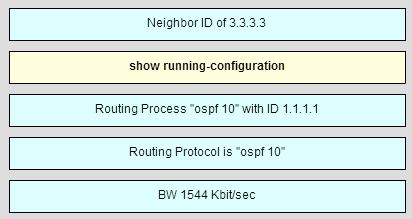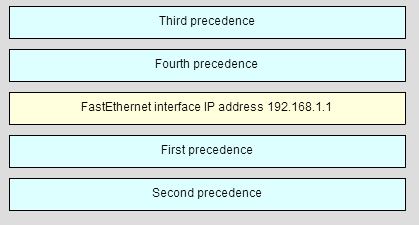Last Updated on April 3, 2018 by Admin
CCNA 2 Chapter 8
From year to year, Cisco has updated many versions with difference questions. The latest version is version 6.0 in 2018. What is your version? It depends on your instructor creating your class. We recommend you to go thought all version if you are not clear. While you take online test with netacad.com, You may get random questions from all version. Each version have 1 to 10 different questions or more. After you review all questions, You should practice with our online test system by go to "Online Test" link below.
| Version 5.02 | Version 5.03 | Version 6.0 | Online Assessment |
| Chapter 8 Exam | Chapter 8 Exam | Chapter 8 Exam | Online Test |
| Next Chapter | |||
| Chapter 9 Exam | Chapter 9 Exam | Chapter 9 Exam | Online Test |
| Lab Activities | |||
| 8.1.3.3 Packet Tracer – Configuring DHCPv4 Using Cisco IOS | |||
| 8.3.1.2 Packet Tracer – Skills Integration Challenge | |||
-
Which OSPF component is identical in all routers in an OSPF area after convergence?
- adjacency database
- link-state database
- routing table
- SPF tree
-
Which three statements describe features of the OSPF topology table? (Choose three.
- It is a link-state database that represents the network topology.
- Its contents are the result of running the SPF algorithm.
- When converged, all routers in an area have identical topology tables.
- The topology table contains feasible successor routes.
- The table can be viewed via the show ip ospf database command.
- After convergence, the table only contains the lowest cost route entries for all known networks.
-
What is a function of OSPF hello packets?
- to send specifically requested link-state records
- to discover neighbors and build adjacencies between them
- to ensure database synchronization between routers
- to request specific link-state records from neighbor routers
-
Which OPSF packet contains the different types of link-state advertisements?
- hello
- DBD
- LSR
- LSU
- LSAck
-
A router is participating in an OSPFv2 domain. What will always happen if the dead interval expires before the router receives a hello packet from an adjacent DROTHER OSPF router?
- OSPF will run a new DR/BDR election.
- SPF will run and determine which neighbor router is “down”.
- A new dead interval timer of 4 times the hello interval will start.
- OSPF will remove that neighbor from the router link-state database.
-
What are the two purposes of an OSPF router ID? (Choose two.)
- to facilitate the establishment of network convergence
- to uniquely identify the router within the OSPF domain
- to facilitate the transition of the OSPF neighbor state to Full
- to facilitate router participation in the election of the designated router
- to enable the SPF algorithm to determine the lowest cost path
- to remote networks
-
Which criterion is preferred by the router to choose a router ID?
- the IP address of the highest configured loopback interface on the router
- the IP address of the highest active interface on the router
- the router-id rid command
- the IP address of the highest active OSPF-enabled interface
-
Which wildcard mask would be used to advertise the 192.168.5.96/27 network as part of an OSPF configuration?
- 0.0.0.32
- 0.0.0.31
- 255.255.255.224
- 255.255.255.223
-
Which command should be used to check the OSPF process ID, the router ID, networks the router is advertising, the neighbors the router is receiving updates from, and the default administrative distance?
- show ip protocols
- show ip ospf neighbor
- show ip ospf
- show ip ospf interface
-
Which OSPFv3 function works differently from OSPFv2?
- metric calculation
- hello mechanism
- OSPF packet types
- authentication
- election process
-
Which three statements describe the similarities between OSPFv2 and OSPFv3? (Choose three.)
- They both are link-state protocols.
- They both use the global address as the source address when sending OSPF messages.
- They both share the concept of multiple areas.
- They both support IPsec for authentication.
- They both use the same DR/BDR election process.
- They both have unicast routing enabled by default.
-
What does a Cisco router use automatically to create link-local addresses on serial interfaces when OSPFv3 is implemented?
- the highest MAC address available on the router, the FE80::/10 prefix, and the EUI-48 process
- the FE80::/10 prefix and the EUI-48 process
- the MAC address of the serial interface, the FE80::/10 prefix, and the EUI-64 process
- an Ethernet interface MAC address available on the router, the FE80::/10 prefix, and the EUI-64 process
-
A network administrator enters the command ipv6 router ospf 64 in global configuration mode. What is the result of this command?
- The router will be assigned an autonomous system number of 64.
- The router will be assigned a router ID of 64.
- The reference bandwidth will be set to 64 Mb/s.
- The OSPFv3 process will be assigned an ID of 64.
-
When a network engineer is configuring OSPFv3 on a router, which command would the engineer issue immediately before configuring the router ID?
- ipv6 ospf 10 area 0
- ipv6 router ospf 10
- interface serial 0/0/1
- clear ipv6 ospf process
-
Single area OSPFv3 has been enabled on a router via the ipv6 router ospf 20 command. Which command will enable this OSPFv3 process on an interface of that router?
- ipv6 ospf 0 area 0
- ipv6 ospf 20 area 20
- ipv6 ospf 0 area 20
- ipv6 ospf 20 area 0
-
Which command will verify that a router that is running OSPFv3 has formed an adjacency with other routers in its OSPF area?
- show running-configuration
- show ipv6 ospf neighbor
- show ipv6 route ospf
- show ipv6 interface brief
-
Which command will provide information specific to OSPFv3 routes in the routing table?
- show ip route ospf
- show ip route
- show ipv6 route
- show ipv6 route ospf
-
Fill in the blank.
The election of a DR and a BDR takes place on multiaccess networks, such as Ethernet networks.
-
Fill in the blank.
OSPF uses cost as a metric.
-
Fill in the blank. Do not use abbreviations.
To quickly verify OSPFv3 configuration information including the OSPF process ID, the router ID, and the interfaces enabled for OSPFv3, you need to issue the command show ipv6 protocols .
-
Match the information to the command that is used to obtain the information. (Not all options are used.)
-
By order of precedence, match the selection of router ID for an OSPF-enabled router to the possible router ID options. (Not all options are used.)
-
Match the description to the term. (Not all options are used.)
-
Open the PT Activity. Perform the tasks in the activity instructions and then complete the task.
What message is displayed on www.ciscoville.com?
- Finished!
- Completion!
- Success!
- Converged!
From year to year, Cisco has updated many versions with difference questions. The latest version is version 6.0 in 2018. What is your version? It depends on your instructor creating your class. We recommend you to go thought all version if you are not clear. While you take online test with netacad.com, You may get random questions from all version. Each version have 1 to 10 different questions or more. After you review all questions, You should practice with our online test system by go to "Online Test" link below.
| Version 5.02 | Version 5.03 | Version 6.0 | Online Assessment |
| Chapter 8 Exam | Chapter 8 Exam | Chapter 8 Exam | Online Test |
| Next Chapter | |||
| Chapter 9 Exam | Chapter 9 Exam | Chapter 9 Exam | Online Test |
| Lab Activities | |||
| 8.1.3.3 Packet Tracer – Configuring DHCPv4 Using Cisco IOS | |||
| 8.3.1.2 Packet Tracer – Skills Integration Challenge | |||


